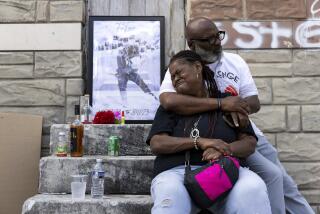She Left a Legacy of Laughter
The cheat was not her life.
The cheat was her death.
To Helen Hawkinsâ family, the bullet that struck her when she was a baby and damaged her brain was just a fact. And the 18 years that followed -- years they spent pushing her in her wheelchair, bathing her, feeding her, diapering her -- were not cause for regret.
âI didnât care how she was,â said her aunt, Annie Mae Hawkins. âShe was beautiful.â
Helen Hawkins, 19, was buried earlier this month in a small Antelope Valley ceremony. She had died in her sleep after taking ill the night before.
Her death was little-noticed outside the family -- not like the shooting that injured her nearly two decades ago.
Back then, the story of the 9-month-old caught in gang crossfire grabbed headlines; it was a crime that focused public attention on street violence.
Helen was shot shortly after 2 p.m. on Dec. 20, 1985. Her mother, Linda Edwards, was holding the baby in her arms at a bus stop near Crenshaw Boulevard and 50th Street in southwest Los Angeles.
Edwardsâ son was standing near them and got into a fight with rival gang members, who had pulled up in a car.
A 16-year-old friend of the son, also at the bus stop, tried to go to his aid. He pulled a .22-caliber revolver and fired several times, according to the police report, but missed the combatants.
It took a few moments for Edwards to realize that the infant in her arms was bleeding, the report said.
âI didnât want to shoot the baby,â the 16-year-old shooter told detectives.
The teenager served less than two years of a 10-year sentence but returned to prison several more times after other convictions, police said. Today, Derek Harmon is a third-striker serving a 25-year sentence on drug charges, said Los Angeles Police Det. Willie Sera.
The bullet lodged somewhere behind Helenâs ear, where it could not be safely removed. The injury to her brain was irreversible. When members of her family took her home from the hospital, they said, doctors told them she would live three weeks at most.
Then the media coverage dropped away, the Hawkins family recalled.
But Helenâs story continued unnoticed. She and her sisters remained with their mother for a time.
But Edwards soon dropped out of their lives, according to relatives. They say that they have lost touch with her and that she lives out of state. Attempts by The Times to find her were not successful.
Helenâs father, however, lives and works in Los Angeles and remained active in her life. After a few years of caring for the girls alone, Eugene Hawkins asked his brotherâs family for help.
Helenâs uncle was a former ice cream truck driver with diabetes. His wife, Annie Mae Hawkins, has a long history of heart trouble. They already had seven children. Their lives had been difficult. They had lost one son to homicide. And they lived on disability checks.
Yet the Mississippi-born pair took in 4-year-old Helen and her two sisters, blending them into their close-knit household. âI was used to children. I was pleased to take in children,â Annie Mae Hawkins said, shrugging.
So Helen became part of a big, noisy family of 12. Her father visited regularly. Helenâs aunt doted on her, cooking her favorite dish, spaghetti and meatballs, and feeding her. Helenâs cousins braided her hair. Her sisters stood her up, her hands balanced in theirs, so they could teach her to dance.
Helen remained small, never weighing more than 48 pounds. Her arms and legs never functioned well enough for her to walk or feed herself -- with the exception of the occasional French fry. She did not seem to understand much of what went on around her and never spoke more than a handful of words.
She was visually impaired but not completely blind; she could see well close up. The seizures she suffered after the injury eventually stopped. She was animated and responsive.
And she was a presence -- her personality unmistakable. When she liked something, or disliked something, she made it known, relatives said. She could be ornery and pouty. One of the words she could say clearly was âNo!â
Mostly, though, she beamed. She had a big, radiant smile that shifted easily into uproarious, hiccuping laughter. Helen laughed often, her family said, at all kinds of things. She seemed incapable of sorrow.
She laughed when they tried to explain to her that there was a bullet stuck in her brain. She laughed at having to be diapered. She laughed at the mention of a loved one who had recently died.
Her family learned to take the laughter in stride. She applied gaiety to situations in which it didnât seem to fit and made it seem natural.
âLike a beautiful little child,â said Annie Mae Hawkins, in tears. She sat in her living room, surrounded by children and grandchildren as she talked, the walls plastered floor to ceiling with family photos. Her husband died in 1996.
Helen, she said, was âmy one daughter who didnât grow up.â
The family believes that complications from the shooting killed Helen, that she was the victim of a slow-motion homicide that took nearly 19 years to claim its victim. Authorities are waiting for the coroner to determine the cause of death.
Helenâs story underscores an often overlooked aspect of urban violence. Gunshot victims sometimes die after years, causing police to dig up old, forgotten case files.
Annie Mae Hawkins said that although Helen had been under a doctorâs care, she had not been ill or in pain until the night of her death, when she had indicated she had a stomachache and went to bed.
Her face seemed a little swollen, but Annie Mae Hawkins went to sleep thinking nothing was seriously wrong.
She woke up a few hours later worrying that the house seemed too quiet. She went into the room Helen shared with her two sisters and found her lying in bed, cold.
She is angry only that Helen did not have more time.
âI donât think Iâll ever get over it,â she said.
More to Read
Sign up for Essential California
The most important California stories and recommendations in your inbox every morning.
You may occasionally receive promotional content from the Los Angeles Times.










